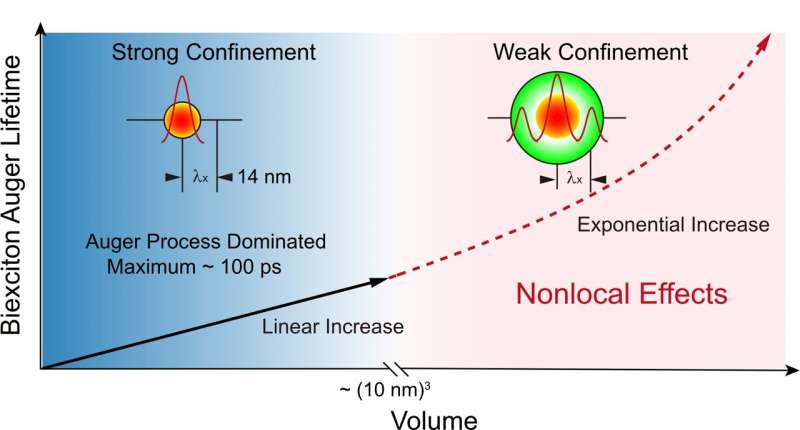Auger recombination lifetime linearly increases with volume in strong confinement regime (left), while exponentially increases in weak confinement regime (right) due to nonlocal effects. Credit: Peng Huang, Shipei Sun, Hairui Lei, Yongyou Zhang, Haiyan Qin and Haizheng Zhong
In a new paper published in eLight, a team of scientists led by Professors Haizheng Zhong and Yongyou Zhang from the Beijing Institute of Technology and Professor Haiyan Qin from Zhejiang University have discovered nonlocal effects in large semiconductor nanocrystals. They provide new strategies to achieve high-efficiency multiple excitons for quantum optics and energy conversation applications.
Auger recombination in bulk materials only slightly affects the biexciton recombination due to the lower carrier density and momentum conservation. Thick-shelled CdSe/CdS nanocrystals were developed to suppress Auger recombination to gain high biexciton efficiency. The research team achieved this by reducing the wave function overlap between the electrons and holes.
Large colloidal QDs may be suitable candidates to generate efficient biexciton emission, but have rarely been investigated. The research team reported that the Auger recombination rate in large perovskite nanocrystals could be exponentially decreased due to the nonlocal effects.
Nonlocal effects refer to the influence of wave spatial dispersion on the light-matter interactions. Nonlocal effects have been successfully demonstrated in plasmonics to explain optical response in metallic nanostructures. Auger recombination can be described as an energy shift from an exciton to another electron or hole or a process in which one electron or hole absorbs an exciton to a higher energy level. Accordingly, the nonlocal effects of Auger recombination are mainly determined by the wavefunction of the exciton.
At room temperature, the estimated wavelength of an exciton in CsPbBr3 is ~14 nm, enabling the possibility to observe the nonlocal interaction enhanced biexciton emission in large nanocrystals with a size of > 14 nm. Benefiting from the unique defects tolerance ability of perovskite nanocrystals, the research team observed high biexciton efficiency in large CsPbBr3 nanocrystals.
There is a linear relation between the biexciton Auger recombination lifetime and volume for small nanocrystals. The maximum biexciton lifetime is ~100 ps due to the strong Auger recombination. For bulk materials, Auger recombination is mainly related to the carrier density and band structure with a constant coefficient. For example, a bulk crystal with a carrier density of 1018 is predicted to have a biexciton lifetime of ~10 ns.
In the mesoscale region, the nonlocal effects are expected to alternate the biexciton lifetime with volume from linear scaling to exponential, which is observed in large CsPbBr3 nanocrystals for the first time.
In conclusion, the research team discovered nonlocal effects of biexciton emission in CsPbBr3 nanocrystals by comparing their spectroscopic results of large nanocrystals with previously reported small nanocrystals. Such a nonlocal effect can be illustrated by considering the nonlocal interactions between carriers and excitons on Auger recombination.
With volume increasing, the Auger recombination rate of large CsPbBr3 nanocrystals can be exponentially reduced to achieve high biexciton efficiency of up to 80%. The discovered nonlocal effects in large nanocrystals provide a guideline to fabricate advanced quantum emitters with efficient biexciton (multiple excitons) emission and create new opportunities to explore semiconductor nanocrystals beyond strong quantum confinement.
More information: Peng Huang et al, Nonlocal interaction enhanced biexciton emission in large CsPbBr3 nanocrystals, eLight (2023). DOI: 10.1186/s43593-023-00045-3
Provided by Chinese Academy of Sciences
























